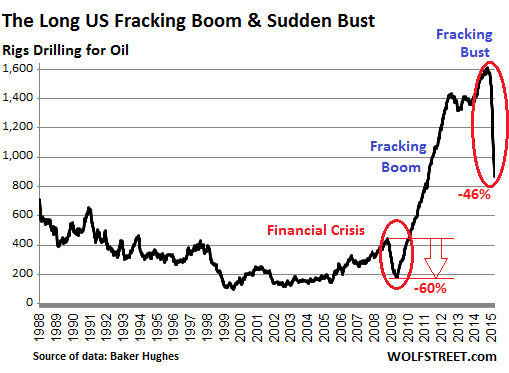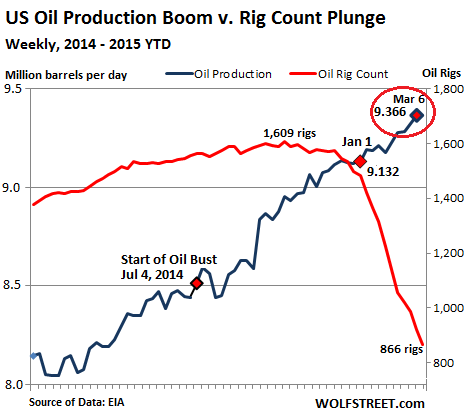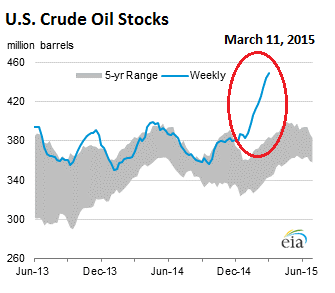The price of Oil did today what it has been doing for a while: it waits for a trigger and plunges. As I’m writing this, West Texas Intermediate is down 4.4%, trading at $44.99 a barrel, less than a measly buck away from this oil bust’s January low. It’s down over 20% from the peak of the most recent sucker rally.
US oil drillers have been responding by slashing capital expenditures, including drilling, in a deceptively brutal manner. In the latest week, drillers idled 56 rigs that were classified as drilling for oil, according to Baker Hughes. Only 866 rigs were still active, down 46.2% from October, when they’d peaked at 1,609. In the 22 weeks since, drillers have taken out 743 rigs, the most dizzying cliff dive in the data series, and probably in history:
You’d think this sort of plunge in drilling activity would curtail production. Eventually it might. But for now, the industry has focused on efficiencies, improved drilling technologies, and the most productive plays. Drillers are trying to raise production but with less money so that they can meet their debt payments. Thousands of wells have been drilled recently but haven’t been completed and aren’t yet producing. This is the “fracklog,” a phenomenon that has been dogging natural gas for years.
So US oil production hit another record of 9.366 million barrels per day for the week ended March 6, according to the Energy Information Administration’s latest estimate. This chart shows how the rig count (red) has plunged while production (black) continues to soar:
But demand is not living up to the level of production and imports. As an inevitable result, US crude oil inventories are piling up. Excluding the Strategic Petroleum Reserve, crude oil stocks, according to the EIA, rose by 4.5 million barrels in the latest reporting week, to a record 448.9 million barrels. A more modest rise than in prior weeks, but the ninth week in a row of increases. Crude oil stocks are now 78.9 million barrels, or 21.3%, higher than at this time last year. Note the beautiful spike:
So when is US storage capacity going to be full? That event would cause all sorts of havoc in the oil markets, including a terrible plunge in price. With no place to put their oil, some production companies would have to turn off the tap and leave the oil in the ground. That would bring production down in a hurry, but it would add to the pent-up supply, the “fracklog,” thus dragging out the bust even further.
How likely is this scenario?
Last week, the EIA released estimates that crude oil stocks nationwide, as of on February 20, were at 60% of “working storage capacity,” up from 48% last year at that time. In critical Cushing, Oklahoma, which accounts for 14% of the national total and is the delivery point for WTI futures contracts, storage facilities were 67% full.
Given a storage capacity of 521 million barrels, if weekly increases amount to an average of 5 million barrels going forward, it would take about 3 months to fill the remaining capacity. Cushing would be full sooner, which would pose its own set of problems.
But we’re not biting our nails just yet. The largest US refinery strike in 30 years that impacted 12 refineries and a fifth of US refining capacity appears to be settled. A tentative agreement has been reached between the United Steelworkers union and oil companies. Once these refineries are fully operational again, more crude will head their way. The driving season will start soon. SUVs and pickups and even fuel misers have a prodigious appetite collectively and can burn through a lot of gasoline in a hurry. And imports could be throttled back further.
So there is a very good chance that storage capacity will disappear as a death trap for the price of oil this year. But US oil production is likely to continue to rise, leaving the industry to face an even bigger oil glut and even more price mayhem next year. Yet production won’t start declining until the money runs out.
Some smaller oil and gas companies are already running out of money. For them, “restructuring” and “bankruptcy” are suddenly the operative terms. Read… “Default Monday”: Oil & Gas Companies Face Their Creditors
Enjoy reading WOLF STREET and want to support it? You can donate. I appreciate it immensely. Click on the mug to find out how:
![]()





Hey Wolf, so I would be curious to get your take on what role the US dollar index has on the price of Oil (WTI) . If you look at this chart
http://www.macrotrends.net/chart/1334/dollar-gold-and-oil-historical-chart
one can arrive at some interesting scenarios. It will be interesting to see if the dollar goes much higher than it current 100.18 (current level at time of writing). If the the past is any indication, the price of WTI could drop into the high $20 or $30 if the dollar continues on its trajectory. This article from oilprice.com is what spurred my interest in the relationship between the strength or weakness of the dollar in relation to the price of crude oil (WTI).
http://oilprice.com/Energy/Oil-Prices/Why-Oils-Recent-Drop-Indicates-Strength-Not-Weakness.html
Cheers!
Blame the government who will not let us export crude oil
Who would buy it, Mary? Not all oil has the same energy content and refineries have specific set ups.
We need to stop subsidizing oil companies, banks, other financial institutions, automotive industries, and 93 millions that have given up looking for a job. The bases of all these bailouts is due to overreach by the government. You cannot let the laws of economics play out. With cheap oil prices and a true unemployment rate of almost 30%, there is no reason American companies cannot not come by to the States. Yes, we need to start exporting. If we don’t, we will discourage the energy sector from further innovations. Our national debt is the debit card for big business and big government.
So many factors weighing on oil, hard to keep track, and now another, Iran. If the deal goes through, Iran will come back on the market as a major supplier. That would trump any and all other news. I don’t think the fears over storage capacity have really had an affect yet, so if they don’t amount to anything, it won’t make a difference.
USD strength, falling demand, rising supply, these are enough to drive oil lower, and after all, this is an orchestrated event anyway, so oil is going lower because powerful people want it lower. Yes, the circumstances justify it, and it should’ve happened much earlier, but for whatever reason, now was chosen as the time.
With all of this going on in the industry, why is the retail price of fuel not dropping?
Today, Costco 2.19, January Costco 1.89!
Everyone now locked into Obamacare?
Cheers.
I’m guessing that the shortages from the strikes were taken advantage of by the refiners to run the price back up.. in So Oregon regular is closer to $3 than what you show and the west coast refiners weren’t involved as far as I know. Could have just been the supply demand matrix too (sure). With all the abundance of supply of crude driving its price down should show up at the pumps this summer… or the spread will just show up as huge profits. After all there really aren’t any free markets are there.